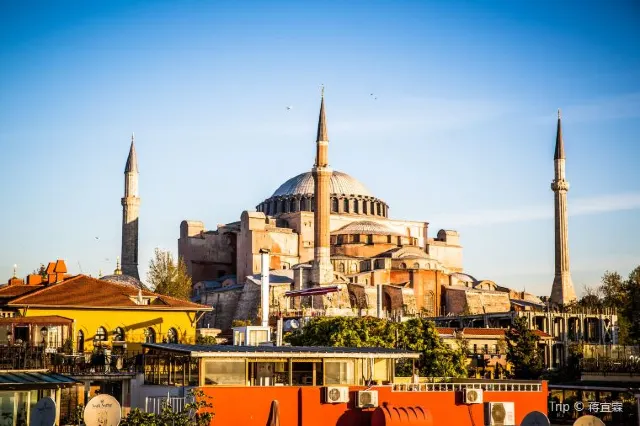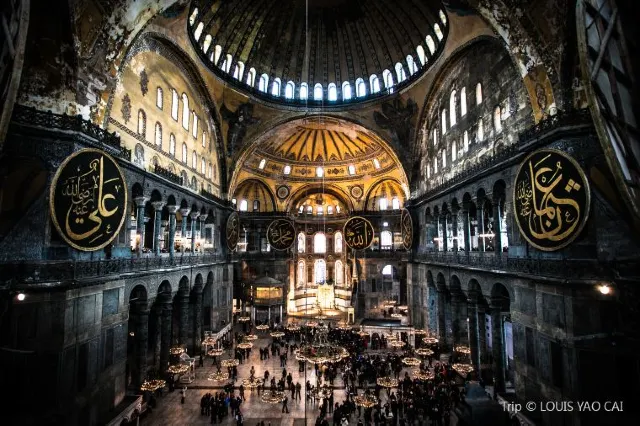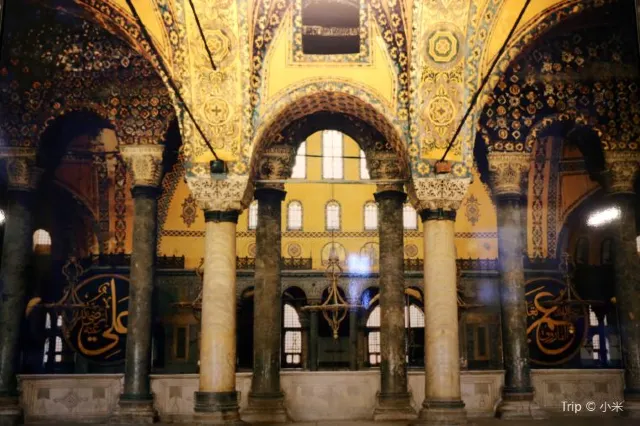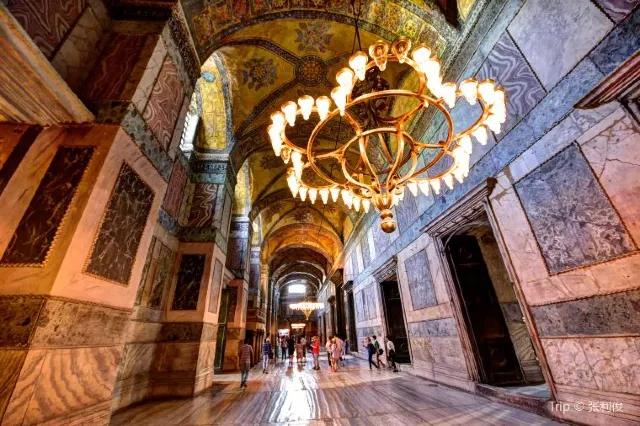A Guide to Instanbul's Hagia Sophia Museum
Catalogue
- The intriguing Emperor Door:
- The Mosaic at the Imperial Gate
- What's in a name?
- The coronation symbols of the Byzantine:
- The nave and its resplendence
- The dome's Islamic scripture
- The grand Mosaics
- The Pantocrator Christ Deësis mosaic
- The other wonders of the Hagia Sophia
- The Cenotaph of Enrico Dandolo
- The Halfdane Viking inscription
- A visit to the museum
- Parting notes
- Attractions near Hagia Sophia Museum
Show More
If you are touring Istanbul, Turkey and want to take in the world’s most important cauldron of two cultures, you will need to plan your trip to the Hagia Sophia Museum or Aya Sofya as it is also known to the world. Not many people aware that you need to buy your skip-the-line tickets for the Hagia Sophia Museum well ahead of time and to ensure you visit in the evening session. Normally during winter, the last session is at 5 pm and in summer it is at 3 pm. An insider tip for the discerning: plan your visit between March to May or September to November. Why? Well for one, the temperature is relatively cold and relaxed than the rest of the year. Also, it is the off-season for the hotels, so rates get cheaper and the city is also not so crowded! So let’s delve into how you can enjoy your trip to the Aya Sofya without much ado.
The Hagia Sophia Museum is a doorway to the remnants of two important cultures and religiosities that intrigues the curious traveler. The Aya Sofya really isn’t just a museum. To be more discerning one has to go beyond the colossal size and the grandeur of the mosaics to understand the history of the building and the way the Ottoman and Byzantine emperors used it. This allows you to get a grip on its true intrinsic value as a surviving doorway to the past. Let us briefly touch upon its story, what is there to gaze and how you can really enjoy your trip to the Hagia Sophia Museum and Istanbul itself. Just for a moment, travel back in time, shut out the world and its noise and breathe in the aura of the place. Here is what you will find as you move from the outside narthex or entrance-area, through the door at the centre and into the interior area.

The centre door is huge and named so by the Emperors of the Byzantine period who were the exclusive users. The 7m high door sets the pace for your discoveries of Hagia Sophia Museum and its benevolent treasures. Do you know the history behind the second-century panels of oak or its frame of bronze that make up this massive gate? The door found its way here from a Tarsus pagan temple. Many including contemporary historians believe the wood was from Noah’s Ark or the biblical Ark of the Covenant holding the two stone tablets given to Moses by God and thus, is a part of the two diverse yet important religious sentiments of both Christian and Moslem culture.

Wait a moment here and look upwards. See those magnificent mosaics on the ceiling of the narthex of the Hagia Sophia Museum? The doorway mosaic is especially famous, as it reads, “Peace to all of you who enter, for I am the Light of the World.” It feels like the ‘Christ Enthroned’ mosaic speaks and sets the pace for the onlookers with the depiction of Leo the Sixth, the Byzantine Emperor bowing down to Christ on his throne. Just over the main entrance called the Imperial Doorway, you will also see the mosaic depicting the Pantocrator Christ flanked on either side by Emperor Constantine the Ninth and his Empress Zoe.
Plenty! Hagia Sophia in Greek means ‘Wisdom that is divine’ and was a tribute to it being a church of the Greek Orthodox sect and not a dedication to St. Sophia as many people wrongly believed. Aya Sophia in Turkish is also used to notate this Byzantine Orthodox church when it was converted for nearly 500 years into an Ottoman Mosque and finally turned into a museum! Presently the UNESCO tag of world heritage has been awarded to this Byzantine architectural site which is by far the most important museum in Istanbul and centrally located in the central neighbourhood of Sultanahmet at Istanbul. What an ode to light and the Christ are revered in both religions at the very doorway to the structure!
Our very first steps into the structure of the Hagia Sophia Museum reveal the circular marble marks on the floor of the ‘Omphalion’ or where the Emperors of the Constantinople once stood for their coronation and bowed to the patriarch of this Basilica. The marks were integrated well by the Ottoman Sultan’s additions of the pulpit area or minbar as it is known. These marks of ceremonial value are also representative of the Christ and his twelve apostles and the earth with its heavenly bodies surrounding it.
Awestruck by the Hagia Sophia Museum? That is exactly how you feel as you stand below the imposing dome in the very grand nave or heart of the structure. Even the Emperor Justinian the First, when first looked up at the dome felt and said he had surpassed King Solomon’s efforts in building a temple to the Lord with this building! Revel a moment here in the absolute size and beauty of the entirety of the dome balanced on 107 columns. It is truly monumental and so is its history. The Byzantine empire spanned great areas, and the prized materials from its length and breadth were used in the construction of the Hagia Sophia. You will find columns from the Ephesian Temple of Artemis, also an ancient marvel, the Helen of Troy columns, the green marble of Thessalonica, the huge Egyptian stones, the yellow Syrian stones, and the black Bosphorian stones. Phew! What a large empire!
The story behind the Hagia Sophia Museum architecture is also very intriguing and testifies the architectural skills of the period. The emperor wanted to build an unmatched basilica that no man had imagined till then. And, that is what he did! Post the victory in the Nika upheaval riots that were political, violent and destructive, he set about building the Hagia Sophia at the same place were the destroyed wooden basilica once stood. He wanted a huge dome to rest on the square base structure which could withstand the travails of time in an earthquake-prone area. The two architects commissioned by him Isidoros of Miletus and Anthemius of Tralles were true revolutionary innovators with great mathematical skills. Till date, the stability of the structure is a marvel, as it incorporates the ingenuity of concave triangular pendentives, allowing the slightly modified and not completely round central dome with its associated semi dome-like structures, to support the main dome and remain a scientific and ingenious marvel that stands the trials of fire, earthquakes and time. Nearly 1500 years later, the Hagia Sophia dome which is 31m wide, 56m high stands colossal and majestically in tribute to the Byzantine Empire and its construction skills.

When the Ottoman rulers gained control, many buildings were Islamized as was their norm. Mosaics were covered over and inscriptions placed over them. The Hagia Sophia Museum is the torchbearer of light, peace and wisdom and it has remained so since inception. During the Ottoman rule, it was used as a mosque and the Christian mosaics were covered with white-wash and gold scripted inscriptions. Ottoman ruler Sultan Abdülmecid who renovated the basilica after gaining power had the calligrapher Kazasker Mustafa Izzet Efendi place the Koran’s 35th verse on the dome. It is significant that this verse alludes to the light of the world in perfect harmony with the thought behind the original structure and the inscription over the Imperial doorway! The columns also bear golden scripted wooden circular plaques and inscriptions of the four first Caliphs on wooden circular plaques hanging on the main supporting building piers. The mihrab pulpit or niche directed towards Mecca lies within the apse of the domed structure. The modern reconstruction of 1931 restored most mosaics of the Aya Sofya and also allowed the dome inscriptions to survive no matter what lay beneath them, as a true move to integrate and retain the spirit of the Hagia Sophia.

Moving on and onto the upper galleries of the Hagia Sophia Museum, we arrive at the Empresses western balcony which has the most breath-taking view of the entire building. Some of the unexpected historical details depicting feminism remain etched in the northern gallery, which was used by the womenfolk in Byzantine times. The Southern galleries lead to the Emperor’s chambers and that is where the Deësis mosaic can be found.
Each mosaic at the Hagia Sophia Museum is there with a story of its own. But the most enthralling is the 13th century Christ Pantocrator ( meaning God in Hebrew) mosaic where the Virgin Mother, John the Baptist and Christ himself pray for Judgement Day salvation for humanity. The mosaic was installed as a victory tribute to the Orthodox Christians overcoming the Catholicism of the Romans. The soft features, the erosion of the lower half of the mosaic, the fine detailing and the incredible beauty of this mosaic is one of the most important remnants at the Hagia Sophia.
The mosaic of Virgin Mary: The Byzantine Emperor Justinian on the left and Constantine on the right are depicted with the Virgin Mother Mary who is being offered the Hagia Sophia and the city of Constantinople. The mosaic sits just above the main entrance doorway exiting the Hagia Sophia Museum as a reminder of the fervor and adoration she received in the 11th-century rule of these famous Byzantine sons.
The Tombs of the Ottomans: The Hagia Sophia Museum is also very special as it contains the mortal remains of the five Ottoman Sultans who rest right next to the Baptistery of St John outside the doorway building exiting the Aya Sofya. The interiors of the mausoleums are lavish and filled with intricate Iznik handiwork.
The Curative Weeping or Sweating Column: On the northern end of the aisle leading to the Imperial Emperor Door is another of Hagia Sophia Museum’s important well-preserved secrets called the Weeping Column. The column has a tale woven into its background and is supposedly blessed by the saint Gregory who was attributed with working many miracles. People till this day place their finger inside the column’s watery finger-hole expecting to be cured of chronic illnesses.
Just across this beautiful mosaic of the Christ Pantocrator at the Hagia Sophia Museum, lie the remains of the 42nd Venetian Doge Enrico Dandolo. The Doge was the commander of the crusaders in 1204 when the Latins looted, destroyed and desecrated history. Surprisingly it is an ironical story of power and the fact that death equalizes both the beauty and the beast. The modern reconstruction, let the remains be, for fear of damage to the stability of the building.
This inscription is runic, small and almost unnoticeable in the marble. It says ‘ Halfdane was present here’ and alludes to the presence of the members of the Varangian Guard of mercenaries who left their signature for posterity on the Hagia Sophia Museum southern gallery’s bannisters just across the wondrous Deësis panel mosaic.
The official address is Hagia Sophia Museum or Aya Sofya Meydani, Sultanahmet, Istanbul. The Hagia Sophia remains open from Tuesday to Sunday from nine in the morning to five in the evening with the last 4 pm entry during the winter October 25th to April 15th months and up till 7 pm in the summer April 15th to October 25th months. Your skip-the-line e-ticket is available online at the Turkey Museums official website and allows you direct entry avoiding the crowds at the entrance queues. The old and grand Hagia Sophia’s history has many stories that can enliven your visit if you have a good guide. The official guides are available at the entrance though it is better to use the services of a comprehensive package where the services of the guide are inbuilt keeping the group’s linguistic diversity in mind. Here are some crucial details.
The Hagia Sophia Museum /AyaSofya Müzesi, Sultanahmet – Istanbul.
Tel: ( 90 212) 528 45 00 and 522 17 50
Ticket price: 72 Turkish Lira-TL
Take note that there may be changes to the functioning times, local holidays and schedules, admission fees and such and it is best to verify the information by phone.

How to tour the Hagia Sophia:
Are you on a tight budget and want to squeeze in as much as possible besides the Hagia Sophia Museum at Istanbul? You can opt for the day tours at Trip.com where you can club your cheap flight tickets with greatly discounted fares for hotel bookings and day tours. You can also opt to stay in the many readily-available hostels, dormitories, etc with other co-travellers. Using the dolmus buses instead of the expensive taxis is a good option. Eat well and enjoy the local cuisine that has a huge variety. Buy yourself an Istanbul Travel Card that can be refilled at any of the kiosks at the airport, metro and so on. Never buy a single-way ticket which is twice as expensive as using the card! Fly Turkish Airlines or the cheaper Pegasus and Onur Air if you wish to save more. An insider trick is to use the Asian sided Sabiha Gökçen Airport instead of the Atatürk Airport and then use the airport shuttle to Taksim costing just 12 TLs. The day-tours of Istanbul can introduce you to its many attractions like the Hagia Sophia, Basilica Cistern, Topkapi Palace, Hippodrome, Grand Bazaar, and the Blue Mosque. Normally fees, guides, pick-up and drop at your hotel and such are included.
The Hagia Sophia Museum started its life as the Church of Holy Wisdom during the Byzantine times, served as a mosque for 500 years under the Ottoman Sultans and currently serves as the Hagia Sophia Museum. It continues to remain one of Istanbul’s iconic ancient remnants dedicated to peace, culture and wisdom and is a must-visit for tourists.
Use the skip-the-line bookings at Trip.com and wave goodbye to the queues. The Trip.com app can help you find a cheap flight booking for over 5,000 destinations globally. Not only can you compare flights and use the fare finder features, but the website and phone-in service can also help you book your skip-the-line at Hagia Sophia tickets, discounted day-tours, off-season great value hotel bookings and more. The 24 x 7 customer service is free! So why wait? Enjoy the free events and street performances while you shop at the spice markets and use public transportation to discover the Balat neighbourhood or shop at Taksim Square.
The cave churches of Cappadocia: If you thought the Byzantine period was restricted to the Hagia Sophia, you are wrong! You can get more of the ancient sights of the Byzantine ruins of churches, castles and the area of Cappadocia. Discover those wonderful frescoes in the cave churches just outside Istanbul where you can find many such Byzantine remnants.
Ephesus and Troy: You can also travel a bit down, near to the coast to find Troy where the famous Helen lived about 5000 years ago, and the ruins of the ancient Ephesian city which till date are Turkey’s best reminders of the Roman era.
Trending Travelogues
Popular Trip Moments
Popular Travel Types
Popular Attractions
Popular Ranked Lists
Popular Destinations
Recommended Attractions at Popular Destinations
About











Site Operator: Trip.com Travel Singapore Pte. Ltd.







